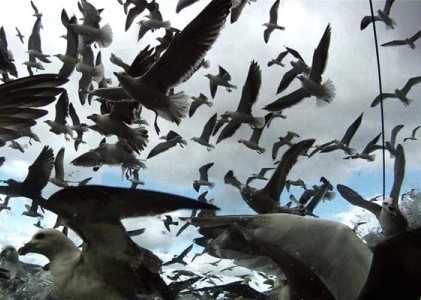Moments of 2012, Part 2
Continuing our annual tradition, we invited some of our regular contributors and colleagues, as well as a few writers and artists, to select their moving image moment or event of 2012—anything from an entire movie or television series to an individual scene or shot, from a retrospective or exhibition to a news story or viral video. Read Part 1 here.
Andréa Picard, curator and writer
2012 was less about a moving-image moment highlight than it was a significant marker in the history of cinema. One self-named Chris, through whom many of my best film and exhibition experiences were inevitably, and in some cases, retrospectively cast—such as the re-appearance of Alberto Grifi and Massimo Sarchielli’s astonishing, spectral Anna (history as fiction and vice versa), a private screening of a new 35mm print of Alain Resnais’s “immemory” masterwork Muriel (as anxiety-inducing and brilliant as ever), seeing Sans Soleil on the big screen the week after Marker’s death (as mysterious, intelligent, and mischievous as ever), Werner Schroeter’s messy and mesmerizing ode to creativity (miraculously reviving Pina Bausch), Wade Guyton’s solo exhibition at the Whitney (technology as alluring, abstract texture), Etel Adnan’s intimate, soulful landscape paintings at Callicoon Fine Arts (lands faraway, where memory and imagination meld).
And there was a special film love letter (A+) that I would be remiss not to mention…(weren’t all of Marker’s, too?)
Kevin B. Lee, critic and filmmaker
Chris Marker's passing on July 29 was a terrible loss, but this year also saw the resurrection of an essential but neglected legacy of the essay film. Commemorating the 50th anniversary of the Oberhausen Manifesto, the short films of its signatories were released on DVD and screened around the world from Paris to MoMA to Buenos Aires. Though they were made in the specific context of overturning postwar West Germany's ersatz cinema, their way of seeing the world is startlingly contemporary and vital in their analytical powers. Seeing them at the Oberhausen Film Festival gave me a new understanding of the essay film as a scientific practice: breaking and boiling down the world into elements, starting from zero to see things anew.
Leo Goldsmith, scholar, curator, and film editor of The Brooklyn Rail
In July, with Rachael Rakes, I co-curated "A Color Box," a small show of moving-image works dealing with the subject of color, at Greenpoint's Heliopolis Gallery. All the artists involved—including Bill Brand, Madison Brookshire, Sandra Gibson, Pierre Hébert, and Eric Ostrowski—were immensely generous with their labor and time, but none more so than Kenny Curwood, whose new three-projector work, pRokudin-Gorskii carBon, became the show's centerpiece. Named for the Russian chemist Sergei Mikhailovich Prokudin-Gorskii, whose early three-color photographic process captured images of his native country before and after the October Revolution, Curwood's work comprises three black-and-white 16mm loops projected through red, green, and blue filters and precariously recombined into a single color image. Given the minute variations in the projectors' speeds, the color image is haphazard and increasingly out-of-synch, forming an unstable, rainbow-edged ghosting that pushes the frame to the edge of decomposition. Brilliant flowers, melting snow, and hovering hummingbirds spring into a fragile existence between realism and abstraction through the artist's artisanal process, which involves a homemade optical printer and jury-rigged EIKI projectors.
Rebekah Rutkoff, critic
A meteor blazes just above the screen at the Temenos in Greece. The perfect accompaniment to Gregory Markopoulos's Eniaios: a spontaneous guest in the theater of expanded cinema
Genevieve Yue, scholar and critic
I’ll admit there was a moment at the beginning of David Gatten’s The Extravagant Shadows, a rather long moment, in which I fidgeted, panicked, and generally resisted the film I’d committed to seeing. But at 175 minutes, the film was longer, and in the time of its texts and applied paint, with words and colors vanishing into the thin mountain air of Gatten’s home, my senses calmed. I began to see the film’s truly extravagant riches, which at first had been barely perceptible: a story of a love affair told in letters, each correspondence weighted with the time of anticipation and waiting, and, on occasion, the sudden appearance of sound, sometimes as slight as the breeze outside the window. In his introduction at the film’s premiere at the New York Film Festival’s Views from the Avant-Garde, Gatten described The Extravagant Shadows as “an offering of protected time.” Once my struggled ceased, I understood what a precious gift this was. It is, in fact, a gift any film might give to us, though rarely are they so generous, so airily patient.
Scott MacDonald, critic
My cine-Moment-of-the-Year was seeing Leviathan, the new film by Lucien Castaing-Taylor and Véréna Paravel, in Alice Tully Hall at the New York Film Festival and hearing the audience applauding even before the credits were over—for a feature-length, non-narrative, experimental "avant-doc." The leviathan in Leviathan is not the Biblical whale, but the film itself, which swallows viewers for 90 minutes then regurgitates them at the end of the most visceral and imaginative film experience of 2012.
Michael Atkinson, critic
A sad, grim, slope-backed year, with even many of the year's best films dragging the shackles of compromise and/or prosaicness, and the landscape coming to be dominated by brawling superheroes and repetitious TV series and a culture-wide, passive-aggressive struggle with social networking media, to both justify our daily existence and prevent it from turning us all into whining publicity vermin. I have no idea why, but my three most memorable confrontations this year have been with elderly women: first, the helpless lost self of unwanted grandma Beulah Bondi in Leo McCarey's Make Way for Tomorrow (1937), just caught up with for the first time, and then Helen Hayes's flustered, neurotic homefront trauma-mom in McCarey's My Son John (1952), just out on DVD and as startling and intimate a vision of curdled American hyper-ideals as any film made in Hollywood until the ‘70s. The third was, of course, Emmanuelle Riva in Haneke's Amour, looking no less beautiful than she did in the ‘60s, and bedevilling in her fierce inhabitation of an ancient body in full stroke-revolt, and in her steely determination to embrace her damnation and slip the coil. She became by the end not merely an axiom of cinema, but a ghost of someone I feel as though I've lost.
Peter Tonguette, critic
When, in a telling moment early in Whit Stillman's Damsels in Distress, co-ed Violet Wister reminds us, "The Lord said, ‘Be fruitful and multiply,'" she is ostensibly trying to account for the seemingly rakish behavior of an anonymous guy who has purchased drinks for a friend of Violet's at a bar. She reckons that many lasting relationships have been initiated through practices such as these, describing the alcohol-ordering fellow as a kind of a modern-day Basil Ransom rather than just a "playboy or operator," as her friend Rose would have it. But Violet's biblical citation also refers to her fighting spirit when it comes to her enthusiasms. Not content to keep her own counsel, Violet spreads the good news about Ronald Firbank, Dunkin' Donuts coffee, and complimentary hotel soap, and expects the students of Seven Oaks College to follow suit. In other words, she seeks to "multiply" herself and create thousands of little Violet Wisters. Not since Kurt Vonnegut's Eliot Rosewater has a character in fiction evoked the Book of Genesis with such self-knowing charm.
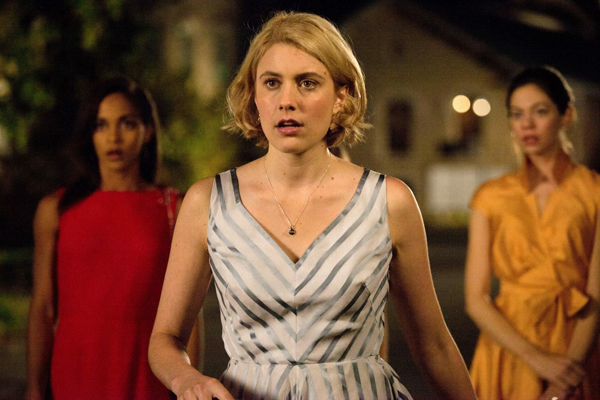
Damsels in Distress
Jordan Mintzer, critic
In the 9-minute elevator sequence that closes Jafar Panahi and Mojtaba Mirtahmasb's This Is Not a Film, a simple trip to throw out the garbage becomes a journey of multiple layers and emotional depth—a perfect example of how the best Iranian films invent their own form of self-reflexive realism to explore what Whitman called the "divine, original concrete." This is the first time we leave the apartment, and also the first time Panahi turns the camera on another character (besides his iguana and co-director): a chatty graduate student moonlighting as a janitor, whose future is as uncertain as the filmmaker's prospective freedom. As the elevator heads downstairs, their conversation comes in fits and starts, between neighborly gossip and allusions to Panahi's arrest, which, in this shrewd politico-cinematic manifesto, is evoked between the two in mostly roundabout ways (after all, who knows who the man reports to). When they reach the basement, the camera continues to follow the student outside, into a darkness alight with the fires of celebration and protest—yet we can only glimpse them from the distance of Pahani's home exile. The gate closes.
Saul Austerlitz, critic
Denis Lavant confronting his daughter (or is she?) in Leos Carax's Holy Motors, damning her faint lies about a party she attended with a verdict that felt more appropriate for other, more venal sins: "Your punishment is to be you. You have to live with yourself."
Dennis Lim, editor, Moving Image Source
There were movies this year that affected me more emotionally (Tabu, Holy Motors) and more viscerally (Leviathan, Django Unchained), but the moment I keep returning to is the Rembrandt scene in Christian Petzold’s Barbara, in which André holds forth to Barbara on the bodily inaccuracies within The Anatomy Lesson of Doctor Tulp, a reproduction of which hangs in his office. It takes a special kind of assurance to stop a film dead in its tracks for an art-history lecture; in the hands of this always precise and ever more confident director, what seems at first to be a superfluous scene becomes an all-encompassing one. First you wonder what might be going on between the two characters—a power play, a test, an intellectual seduction—and then you notice the other, even more tantalizing dynamic in operation, between the painting and the film. Operating on a dizzying number of levels, the Rembrandt opens up a window into history, foregrounds the matter of representation, and poses the question of identification that applies to the film’s characters and viewers alike. It’s a richly allegorical scene as well as a wonderfully literal illustration of a timeless notion: art as a way of seeing the world.
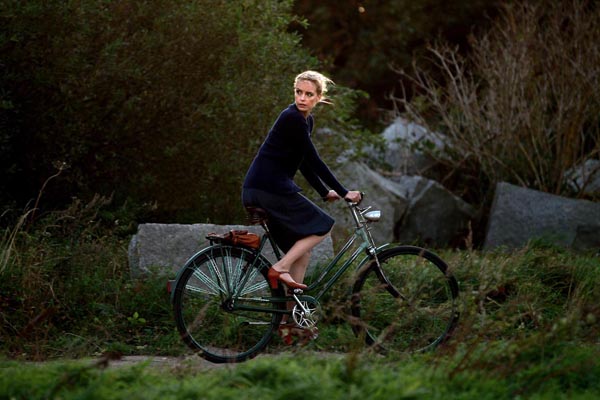
Barbara
Denis Côté, filmmaker
While writing, shooting, and editing my new film in 2012, I needed more than once a lighthouse to help me sail the seas of doubt and confusion. Therefore, my film moment of the year is, of course, Another Country by Hong sang-soo. :)
Florence Almozini, program director, BAMcinématek
This year, I am voting for the best character on film: the lifeguard in Another Country by Hong sang-soo.
Chris Wisniewski, deputy director for education & visitor experience, Museum of the Moving Image
Based on the preponderance of available evidence, it seems that any year that brings a new film from the great British director Terence Davies delivers something worth celebrating. His latest, an adaptation of the Terence Rattigan play The Deep Blue Sea, is full of exceptional moments: the entirety of its opening 10 or so minutes; Rachel Weisz's slow dance with Tom Hiddleston to "You Belong to Me"; the scene outside Weisz's protagonist's apartment with her estranged husband (an exceptional Simon Russell Beale); the sublime musical WWII flashback in the subway station.
As typically searing as these sequences are, though, my moment of the year was not from The Deep Blue Sea but instead harkens all the way back to the late 1980s. While walking into a screening of Davies's 1988 film Distant Voices, Still Lives at the Brooklyn Academy of Music in the late winter/early spring, I ran into a colleague who had only seen one Davies film, 2000's House of Mirth. He was excited to see Distant Voices, but I couldn't contain my enthusiasm for him: "I envy you, seeing this movie for the first time." It turned out I had no cause for envy. During my third time seeing it—the first in a theater with an audience—Distant Voices remained as powerful and poignant as it has ever been. Wiping the tears from my eyes as the film drew to a close, I was grateful for having once again seen a film I would describe, without hesitation, as a masterpiece. And in an odd way, that cinematic experience made me appreciate The Deep Blue Sea even more—as the work of a true master of the medium.
Verena Paravel, filmmaker
" A very rare fishing accident" but an accident that I always dreaded during the shooting of Leviathan...
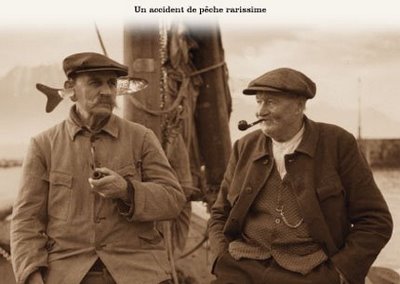
A very rare fishing accident
Melissa Anderson, critic
My moment of the year isn't a sight but sound: Hearing Chic's "At Last I Am Free" over the closing credits of Christian Petzold's flawless GDR thriller Barbara—slow-jam-disco deliverance signaling the promise of a revolution to come.
Michael Glawogger, filmmaker
On October 27 this year, Peter Kubelka hosted a very special evening in Vienna, presenting different screenings of the films Arnulf Rainer and Antiphon—one from 1960, the other from 2012. Two Antipodes: where one film is black, the other is white, where one is noisy, the other is silent. The films were shown one after the other, then next to each other, then one on top of the other. Two projectors were placed in the screening room, as was the director with his unflinching enthusiasm for cinema, art, and cooking—an event of true cinema.
Rachael Rakes, assistant curator of film, Museum of the Moving Image
Stan VanDerBeek had monumental plans for the future of the Movie Drome, the enormous metal dome he built out of a grain silo and installed in his Stony Brook cooperative in 1963, in the middle of which rotated slide, overhead, and film projections, their attendant sounds competing and commingling for prone viewers to take in and edit in their heads. This was to be a prototype-ideally many dromes would arise all around the world, sharing images by satellite, connecting far-flung people through a shared "international picture-language." The dromes did not in fact multiply, but the world is now flooded with images. The New Museum's scaled-down replication of the Movie Drome, installed as part of last summer's Ghosts in the Machine show was a clever act of recontextualization, and at the same time a stimulatingly tangible shared time-based media experience.
Jem Cohen, filmmaker
Thanks to James Quandt/TIFF's traveling Bresson retrospective, I caught a beautiful new print of L'Argent at Film Forum. (Other titles I tried to see were sold out—frustrating, but a good sign). Such prints restore to Bresson's later work a physicality that gets drained away over years of catch-as-catch-can viewings of badly faded color prints. The breathtaking green of the foliage at the country house makes a promising but cursed eden. Beyond just improved color, with original densities restored, one becomes more aware of the film's relentless repeating verticals, often placed smack in the middle of the shot. (It brings to mind, literally, Tarkovsky's notion of "sculpting in time"). I wasn't thinking about this while watching the movie; I was entirely captivated as it rolls towards its brutal dead stop. When the lights came up I felt both punched in the gut and utterly rejuvenated.
Miriam Bale, writer and programmer
The best films I saw this year were shorts. These include the latest by Josh and Benny Safdie, The Black Balloon; Dustin Guy Defa's found-footage masterpiece Family Nightmare; and The Life and Freaky Times of Uncle Luke (Inspired by La Jetée) by artist Jillian Mayer, with the best use of sound and color of any film I saw last year. When shorts are simply sample reels for fantasy features, they can be the biggest waste of time in any viewer's or filmmaker's life. Not so with the shorts I listed, which maximize every minute of the short format. Perhaps they don't seem like auditions or sample reels because they are by established filmmakers or, in Mayer's case, by an "Internet artist" who gives the impression of winging it, of inventing new forms and worlds with every project. (I also highly recommend her viral video I Am Your Grandma and her Erasey Page, as well as her music video that uses talking vaginas as puppets!) Mayer along with the Uncle Luke writer, Lucas Leyva, and Mayer's little dog Shivers are part of a collective that puts on the exciting Borscht Film Festival in Miami. With the release of Amy Seimetz's Sun Don't Shine, Michael Bay's Pain and Gain, and the emergence of the Sarasota Film Festival as a major indie film festival, 2013 looks to be an exciting year for Florida. What? Am I saying that the state where there is a constant stream of news stories about modern cannibals, suicides from women who can't stop coming, and teenagers who steal cash from Girl Scouts will be a major cultural center of the United States? Absolutely!
David Phelps, filmmaker and editor-at-large, La Furia Umana
As the monk-surfer kept whipping himself throughout Joaquim Sapinho´s This Side of Resurrection, a kind of cell-cam Caravaggio, I started asking: how many flagellations is the right number of flagellations to show? Like a lot of calculatingly dour filmmakers—Haneke, the Dardennes, Eugene Green, Nicolas Klotz-Sapinho seems to straddle two contradictory schools, each of which we might label after one of his favorite filmmakers: the school of Bresson (the school of signs, or the school of the instant) and the school of Rozier (or the school of duration), each yielding methodologies to break open the self-contained narratives of "classical cinema" and signal toward the narrative gaps: transitional spaces, dead time, makeshift gestures.
In Bresson, lines are repeated twice and often inverted ("oui oui," "non non"), but one frame is enough to show the farmer's hand slapping his wife's cheek in L´Argent. In Rozier, plot points are carried so far past narrative efficacy, the characters suspended in space and forced to interact ad infinitum, that all narrative goals are abandoned, as they often are in Bresson, to the sway of the present. So Sapinho has it both ways: the flagellations continue past the point of counting, as if they could go on forever, and yet—this sets him apart from those moralizing filmmakers-this truly glorified torture is not sustained but counterpointed by surrounding scenes of surf and his sister's academic rectitude.
In his last two movies (Bosnia Diaries and Resurrection), Sapinho seems to have placed himself in a vital, uncharted movement, alongside Jean-Claude Rousseau and Pedro Costa—two filmmakers also at equal odds to reconcile these two schools. Here, each shot becomes a block of time that can draw out an action infinitely, while each cut pits these fatalistic moments against each other as self-determined alternatives. However these durational shots within the shot collapse the realities of the production and performance into basic documentary, each is still a narrative sign outward: for how their alien figures might or might not adapt to the world they're given.
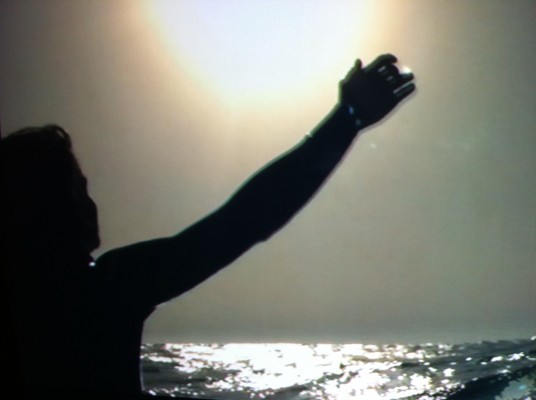
This Side of Resurrection
Aaron Cutler, critic
"There are good movies, there are bad movies, and there are ‘so what?' movies?" Elliott Stein said as we left the theater together. Stein, the Village Voice critic who died last year at age 83, had fallen asleep during the screening, but not before he'd seen enough. This would often happen—Stein slept through parts of more films than most people would ever see in full, ranging from early Hollywood silents to recent Portuguese pleasures, and upon waking would uncork an array of unprompted one-liners ("The director shouldn't talk too much") and trivia treasure troves (cue details about John Farrow's marriages), delivered in a gruff, blunt Brooklyn accent as he shuffled toward the next film. I went with him to several. He'd call to say he had tickets for a Lincoln Center screening, or smuggle me into BAMCinemachat sessions (his monthly BAMCinématek series of rare classics like Alias Nick Beal, The Mad Doctor, and Ramrod) by claiming I was his assistant.
This happened from 2009 to 2010, while I lived in New York. After I met Elliott at a Film Forum British noir series, and told him that I was researching the history of New York's repertory film scene, he gave me a long handwritten list of names and numbers of programmers, critics, and movie nuts that I really needed to talk to. They told me about Elliott, a part of that history: How he had grown up in Brooklyn and gone to NYU, then absorbed the Cinémathèque Française wholesale during his two decades in Paris, worked briefly as a cultural reporter in Brazil, grown close to James Baldwin and Susan Sontag (even partly inspiring her essay "Notes on Camp"), and made enemies with former writing partners Kenneth Anger and Roman Polanski. He called himself a sadist (after de Sade), though could also be sweet and gentle. If he hated you he might walk with your name written under his shoe for a year, but if he liked and trusted you, he'd do anything he could to help.
I had to learn his backstory from others, I thought, as Elliott rarely described himself directly. He preferred to say yes, sure, whatever gossip I'd mentioned was true, add a colorful detail, then switch to dwelling on Charles Laughton and Gabriel Figueroa, and sometimes the theaters where he had seen their films. His mind returned periodically to the Roxy. At first I believed that he would never tell me his story; only later did I realize that he'd been doing so the whole time.
Berenice Reynaud, critic and programmer
On Saturday July 14 2012, at Outfest in Los Angeles, barely containing my emotion, I finally caught a legendary film I had always managed to miss, Queen of Sheba Meets the Atom Man, the 1963 offbeat masterpiece by underground filmmaker Ron Rice (1935–1964), who died too young, of pneumonia, in Mexico. With astonishing playfulness, poetry, freedom of tone and unabashed queerness, the film is everything I had read about—and more. I knew what to expect from Taylor Mead's and Jack Smith's performances—and they were on the crest of their youth, baby-faced, alluring, extravagant. Yet like the Atom Man (played by Mead), I got intoxicated when I met the Queen of Sheba, a divine, sculptural black woman with radiant, soft features and a regal fearlessness in front of the camera.
A boorish writer, in a pseudo-intellectual text, called her naked body "grotesque." Had he ever seen Egyptian, Greek, or African sculptures, paintings by Delacroix or read poems by Baudelaire (Je suis belle, ô mortels, comme un rêve de pierre...)? This is the ultimate goddess, from the time women had heavy breasts, round hips, and fertile wombs. This is the true Queen of Sheba—I am black yet beautiful—that seduced Solomon in all his might. A genius in more than one way, Ron Rice brought a perennial myth back to light, a female power so quietly self-confident that it indulged the whimsical antics of our gay brothers of the wild '60s, men-children who sipped forbidden substances as if they were the fountain of youth and gratefully yielded to the Queen's erotic and motherly seduction.
She was called Winifred Bryan, and the canon of underground cinema has not retained her name. IMDB credits her with the part of "Venoma" in School Play (1970), the sole directorial effort of Charles Rydell, who performed in Rice's Queen of Sheba. A false hope sent me in the direction of an academic, specialized in composition and rhetoric, called Winifred Bryan Horner, whose "own education began relatively late, while she was raising her children." Wini-the-performer, on the other hand, is mentioned in a 1997 interview between Allen Ginsberg and Taylor Mead, as "this great black woman." "I used to know her in the ‘40s," says Ginsberg, who adds that "she was quite intelligent, but he... she (sic) had a wig...." Mead states that "Wini" had died about 10 years prior to their conversation. And that's it!
Wini, why is it that the band of brothers, whom you so subjugated, conspired to keep their names on the marquee of alternative film culture, leaving you in the shadows? You were a woman, you were brave, you were black—are these reasons enough to be marginalized when time comes to write history? Since I bonded with you on this silver screen, I have been waiting for my friends at the Museum of Moving Image to ask me to write this little text. You were my cinematic "moment" of the year, and I hope that, somehow, somewhere, somebody is going to read this and then contact me with information about you. Where were you born? Where is your grave? What else did you do, which books did you read, how did you make a living? I want to know more, you are my unsung heroine. That 14th of July, you made my day. ![]()
LATEST ARTICLES
-20140814-173707-thumb3.jpg)
Fighting Words
by Imogen Sara Smith
posted August 12, 2014

Fighting Words, Part 2
by Imogen Sara Smith
posted August 20, 2014

On the Margins: The Fil…
by Andrew Chan
posted August 12, 2014

Robin Williams: A Sense…
by David Schwartz
posted August 12, 2014
 Moments of 2012, Part 2
Moments of 2012, Part 2
KEYWORDS
Chris Marker | Sergei Mikhailovich Prokudin-Gorskii | Gregory Markopoulos | Leo McCarey | Damsels in Distress | This Is Not a Film | Holy Motors | Another Country | The Deep Blue Sea | Distant Voices | Still Lives | Peter Kubelka | Stan VanDerBeek | This Side of Resurrection | Queen of Sheba Meets the Atom ManRELATED ARTICLE
Moments of 2010 by Various WritersMoments of 2011, Part 1 by Various Writers
More: Article Archive

